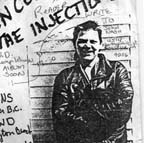(Wallflower/Blues Gangster/BeatHog Dave Rinck introduces a new Che Underground feature with culinary flair.)
 Aside from music, eating is in my opinion “the other” great joyful sensory activity in life. And for the past 20 years, ever since I left San Diego, I’ve had the good fortune to travel the world trying some of the best foods the human race ever invented. (The accompanying photo was taken in one of my favorite restaurants in the Bekaa Valley in Lebanon circa summer 2003. OK, it’s a Hezbullah stronghold — but man, I’d never let a little thing like Islamic fundamentalism stand between me and a good tabouli!)
Aside from music, eating is in my opinion “the other” great joyful sensory activity in life. And for the past 20 years, ever since I left San Diego, I’ve had the good fortune to travel the world trying some of the best foods the human race ever invented. (The accompanying photo was taken in one of my favorite restaurants in the Bekaa Valley in Lebanon circa summer 2003. OK, it’s a Hezbullah stronghold — but man, I’d never let a little thing like Islamic fundamentalism stand between me and a good tabouli!)
Now, there’s really nothing out there that can hold a candle to three rolled tacos with guacamole or a carne asada burrito from Roberto’s, but I have discovered some fantastic grub over the years. So now, just like we’ve shared music we’ve discovered since we parted company, I wanna share with you here one of my all-time fav foods.
Read moreThe Che Underground Cookbook:
Dave Wallflower’s Peri Peri Chicken


 Back in April 2008, Toby Gibson asked the question,
Back in April 2008, Toby Gibson asked the question, 




 I love Ziggy Stardust and Marc Bolan and all that '70s stuff. I mean, I even wanted to cover “Metal Guru” with Fleminger at an open-mic night in San Diego last month. But given the vast sea of discontent that summed up the bloated musical mainstream of the '70s, it was inevitable that a band would eventually appear that would challenge the very concept that pop music can or should have any meaning. “Nihilism” is a great word that gets used very loosely, but if you look it up in the dictionary, you’ll find that it has a very specific and useful meaning:
I love Ziggy Stardust and Marc Bolan and all that '70s stuff. I mean, I even wanted to cover “Metal Guru” with Fleminger at an open-mic night in San Diego last month. But given the vast sea of discontent that summed up the bloated musical mainstream of the '70s, it was inevitable that a band would eventually appear that would challenge the very concept that pop music can or should have any meaning. “Nihilism” is a great word that gets used very loosely, but if you look it up in the dictionary, you’ll find that it has a very specific and useful meaning:
